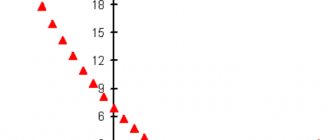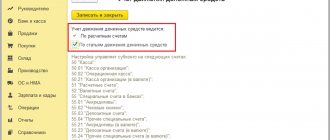Increasing the level of efficient use of assets is an important component for any organization. Inefficient use of property leads to a reduction in production and sales volumes, which subsequently reduces the income of the enterprise. The correct solution to this problem will determine the place of the enterprise in industrial production, its economic condition and competitive advantages in the modern market.
The property of the organization is assets and liabilities.
Before getting to the most interesting part, namely accounting accounts and postings, you need to understand what the property of the enterprise is. We will deal with this issue in this article; more specifically, we will understand such concepts as assets and liabilities of an enterprise. What are assets and what are liabilities? If you can answer this question yourself without any problems, then you can safely skip this article and move on to the next one. Those who do not see much difference between these two concepts or doubt what this or that property of the enterprise belongs to should carefully study the information presented below. Assets and liabilities are what all accounting is based on.
Everything that an organization has (fixed assets, materials, debts, cash) is divided into assets and liabilities. It is very important to learn how to accurately determine whether it is an asset or a liability when looking at an enterprise object. Why is this so important?
Difference between liability and asset:
Those objects that an enterprise owns and which it uses in economic activities to make a profit are called assets. That is, this is all the property of the enterprise with the help of which the enterprise plans to make a profit.
For example, a machine tool is a main tool used in production activities to create products and resell them.
Securities are also an asset, since it is planned to make a profit from them in the future.
Raw materials, materials - similarly, are used in production for further profit.
Goods are purchased for the purpose of their further resale and receipt of revenue.
Finished products are the same.
Accounts receivable is a debt owed to an enterprise by other counterparties, that is, these are funds that the organization plans to receive in the future, that is, also the economic benefit of the enterprise.
Cash - I think it’s clear that this is an asset that the company will invest in the future in the purchase of goods, production, etc. for the purpose of making a profit.
A warehouse is also an asset, as it is used to store goods that the company later sells for profit.
Assets do not suddenly appear out of thin air, they all come from somewhere, their sources of origin are liabilities. Thus, liabilities form assets, let’s confirm this by analyzing several examples:
Authorized capital – contributions of the founders, which become the start-up capital in the activities of the enterprise (that is, the liability “authorized capital” forms the asset “cash, goods and materials”, depending on how the contributions of the founders are made).
Loans are another liability; as a result of taking a loan, we receive money with which we can buy goods, repair a machine, build a new office, etc. That is, credit is a source of asset formation.
Additional capital is additional financial assets that appear in the course of the organization’s activities, for example, due to the revaluation of fixed assets. These funds will be a source for, say, the purchase of materials for production, that is, undoubtedly, additional capital is a liability.
Retained earnings are the organization’s net profit for the year; in the future it can be used for the purchase of materials, fixed assets or their modernization, repairs, etc. accordingly, it is also a liability.
Now let’s summarize what belongs to the assets of the enterprise and what to liabilities.
- movable and immovable property;
- fixed and production assets;
- inventory items;
- cash;
- accounts receivable;
- securities.
- authorized capital;
- retained earnings;
- reserves;
- loans and borrowings from other enterprises and individuals;
- accounts payable;
- taxes, etc.
The assets and liabilities of an enterprise are closely related to each other. If the first ones change, then, accordingly, the second ones change by the same amount. Moreover, as assets increase, liabilities also increase by the same amount. The same goes for decreasing. That is why in the balance sheet the total amount of assets must be equal to the total amount of liabilities.
To track the process of simultaneous changes in both quantities, and also to confirm the equality of liabilities and assets, consider an example.
An organization buys goods for sale for 100,000 rubles. The goods will be an asset of the enterprise; as a result of the purchase of goods, the assets of the enterprise increased by 100,000 rubles. (the product is in stock). At the same time, a receivable from the enterprise to the supplier of goods appeared in the amount of 100,000 rubles. this debt is a liability of the enterprise, that is, as a result of the purchase, liabilities increased by 100,000 rubles. The example confirms the above words.
Let's continue our example a little: the company pays the debt to the supplier in the amount of the same 100,000 rubles. As a result of this business transaction, the amount of funds in the organization’s current account decreased (that is, assets decreased by 100,000 rubles), while the amount of receivables to the supplier decreased (that is, liabilities decreased by the same 100,000 rubles). Again the rule is confirmed: when assets decrease, liabilities also decrease by the same amount.
There are a great many such examples. All of them will confirm the same rule: the total amount of assets in an enterprise is always equal to the total amount of liabilities. If at the end of the year the assets and liabilities of the balance sheet revealed discrepancies in these indicators, then somewhere you made a mistake. Most likely, some business transaction was not reflected correctly, that is, the posting was not drawn up correctly, the accounting accounts for this posting were not selected correctly.
Enterprise property: concept and types
The generalized concept of an enterprise’s property is what it owns: fixed capital and working capital, expressed in monetary form and reflected in the enterprise’s independent balance sheet.
Information about the assets of an enterprise and its financial resources is considered in two aspects - accounting and management. The accounting aspect shows the balance of the enterprise’s assets and its financial resources, and the managerial aspect shows their form (productive, commodity, monetary) and their role in business activity. The assessment of the competitiveness of an enterprise is carried out based on the minimum volumes of assets spent in the process of economic activity per unit of finished product and the minimum balance of permanently assigned assets on the balance sheet of the enterprise, which provide the maximum volumes of business objects.
The assets of an enterprise can be divided into cash and real property. Through investment, funds are transformed into tangible forms of property and vice versa, in the process of selling things create a monetary form of property. Changes in the size of the enterprise's property are carried out through self-financing and by attracting borrowed funds.
Classification of enterprise property
can be carried out on various grounds, highlighting:
movable and immovable property;
property involved in production activities and non-production purposes. In addition to its economic significance, this classification is taken into account when deciding on the calculation of depreciation charges on fixed assets and the repayment of the value of intangible assets;
by type of turnover ability, property is distinguished that is withdrawn from circulation, has limited turnover ability, and that which can be freely alienated and transferred from one person to another;
fixed, working capital - depending on their participation in the production process, the procedure for transferring their value to the cost of manufactured products in parts or in one production cycle, duration of use, value of objects;
tangible (fixed and current assets) and intangible assets. A distinctive feature is the material content of the former and the immaterial form of the latter. Fixed assets and intangible assets also have common characteristics, for example, the possibility of long-term use, the presence of a certain value and the ability to generate income.
classification of property by risk categories during the analysis process
:
minimal risk – cash, easily marketable short-term securities;
low risk – accounts receivable of an enterprise with a stable financial position, inventories of goods of material value, finished products in demand;
medium risk – industrial and technical products, work in progress, deferred expenses;
high risk – accounts receivable from enterprises in difficult financial situations, inventories of finished products that are no longer in use, illiquid assets.
The simplest and most accessible classification of property (assets) is as follows:
current current mobile assets: current assets; expenses; stocks; cash; finished products; accounts receivable; Future expenses .
immobilized non-current assets: fixed assets; intangible assets; short-term investments.
The property of an enterprise appears, on the one hand, in cash or in kind, and on the other hand, in the form of its own or someone else’s. This ambiguity is determined by the structure of the enterprise's balance sheet. If you look from the liability side, you can distinguish the enterprise’s own property, that is, those things that the owners of business entities create for themselves, and someone else’s property, which is formed through loans.
There is such a thing as mobilization property . This is property owned by the organization and used by it to carry out mobilization tasks. The classification of company property as mobilization property is carried out only to the extent necessary to complete such tasks (orders).
Mobilization capacities, depending on the degree of their utilization in peacetime, are divided into three types: used entirely in current production, not used at all, or used partially. In the last two cases, mobilization capacities must be maintained in conditions that ensure their safety and readiness to carry out mobilization tasks (orders).
The above norms are enshrined in paragraphs 2.1 and 2.2 of the Regulations on the procedure for economic stimulation of mobilization preparation of the economy (approved by the Ministry of Economic Development of the Russian Federation No. GG-181, by the Ministry of Finance of the Russian Federation No. 13-6-5/9564, by the Ministry of Taxes of the Russian Federation No. BG-18-01/3 02.12.2002).
Bibliography:
- Gruzinov V.P. Gribov V.D. Enterprise Economics: Textbook. - M. Finance and Statistics, 2002.
- Keiler V.A. Enterprise economics: Course of lectures. - M: INFRA-M-NGAEiU, 2002.
- “Regulations on the procedure for economic stimulation of mobilization preparation of the economy”, approved by the Ministry of Economic Development of the Russian Federation No. GG-181, the Ministry of Finance of the Russian Federation No. 13-6-5/9564, the Ministry of Taxes of the Russian Federation No. BG-18-01/3 12/02/2002
Types of organization property
The property of an organization can be divided into movable and immovable.
The real estate of an organization includes objects that have an inextricable connection with the land, which cannot be moved to another location without causing significant damage. According to the legislation, it includes: land territories and other isolated natural objects, buildings and structures, property complex, unfinished construction site, parking space, pipelines, power lines, built-in elements. All real estate objects are subject to state registration and are subject to tax.
Property that is not included in the designated list is treated as movable.
Movable property consists of tangible assets that can be moved without causing damage to the connecting part. These are company goods, vehicles, money, bonds, ATMs, payment terminals, advertising structures, equipment. The list of movable property can be continued; it includes everything that is not included in real estate. Movable property is not subject to tax.
Enterprise property
Enterprise property - tangible and intangible elements used by the enterprise in production activities.
The property of an enterprise is initially created from property transferred to it by the founders in the form of contributions (contributions, shares). The property of the enterprise increases in the process of production and economic activities. It can be the object of transactions, alienated, mortgaged, etc.
Typically, the property of an enterprise is separate from the property of its founders, participants and employees. An enterprise is liable for its debts with property that belongs to it, which may be subject to claims by business partners or creditors in the event that the enterprise fails to fulfill any obligations to them.
If an enterprise is declared insolvent (bankrupt), its property, in accordance with the procedures established by law, can be used to satisfy the claims of creditors. The remaining property of the liquidated enterprise after this is transferred to its founders (participants) who have real rights to this property or rights of obligations in relation to the enterprise. According to Russian legislation, the founders and participants of an enterprise have rights of obligations in relation to business partnerships and companies. production cooperatives. For the property of state and municipal unitary enterprises. as well as subsidiaries, the founders have the right of ownership or other proprietary rights.
Fixed production assets as enterprise property
For any enterprise, for its normal functioning, it is necessary to have certain funds and sources. Any production process is a process of transformation of objects of labor, carried out by living labor using means of labor. The totality of the means of labor forms fixed assets.
Fixed assets are a collection of items for production and non-production purposes that are repeatedly used in the production process. The definition of fixed assets according to IFRS and Russian standards does not have significant differences. Assets that meet the following requirements are recognized as fixed assets:
– the object is intended for use in the production of products, when performing work or providing services, for the management needs of the organization, or to be provided by the organization for a fee for temporary possession and use or for temporary use;
– the object is intended for use for a long time, i.e. a period lasting more than 12 months or the normal operating cycle if it exceeds 12 months;
– the organization does not intend the subsequent resale of this object;
– the object is capable of bringing economic benefits (income) to the organization in the future.
There are the following types of valuation of fixed assets :
— initial cost is the cost of fixed assets at the time of their commissioning;
— replacement cost is the cost of reproduction of fixed assets under the conditions of a given year, i.e. the year in which they are assessed;
- residual value is the difference between the original (replacement) cost and the amount of their contribution at a given time;
— liquidation value – the cost of selling the balances of fixed assets.
In accordance with the All-Russian Classifier of Fixed Assets (OKOF), fixed assets are accounted for in the following groups:
a) by type :
— buildings, structures;
— machines and equipment (energy, working, information);
— vehicles;
— production and household equipment;
— working and productive livestock;
— perennial plantings;
— other types of fixed assets (library book collections, capital expenditures on leased fixed assets, expenses for reclamation, drainage and other land improvement work).
[flat_ab id=”11"]
b) by industry
— fixed assets of industry;
- Agriculture;
- trade, etc.
c) according to the degree of use in the organization’s activities
— for those in operation;
— in stock (reserve);
— in the stage of completion;
— retrofitting;
— reconstruction and partial liquidation;
- on conservation.
d) according to existing rights to fixed assets
— fixed assets owned by the organization (including leased);
— fixed assets that the organization has under operational management or economic control;
— fixed assets received by the organization for rent.
e) for purposes of production and non-production.
Fixed assets are the most important element of an organization's production resources, since their rational use helps to increase production volumes, reduce production costs, and increase labor productivity. In turn, this will affect the improvement of the values of such indicators as fixed asset turnover, production profitability and, as a result, increasing the profitability of the organization.







